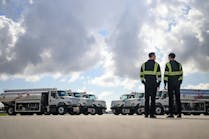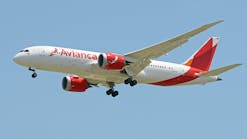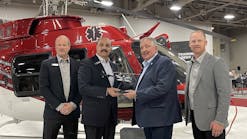An additional NDT method available for inspecting gas turbine engine components
By Joe Escobar
Aircraft maintenance professionals rely on a vast array of nondestructive
testing (NDT) methods in order to detect defects on aircraft. In the area of turbine blade inspection, OEMs and repair facilities have traditionally relied on fluorescent penetrant inspection to identify defects. But there is an inspection technique called krypton gas penetrant inspection that can be used in addition to fluorescent penetrant inspection to enhance flaw detection in turbine blades. In this article, we will take a look at this technology.
Fluorescent penetrant
Fluorescent penetrant inspection is widely used to inspect many areas of the aircraft including critical aircraft engine components. If it is properly applied, fairly high levels of sensitivity can be achieved. But there are many factors that can affect the sensitivity of the inspection. In fact, in the report Study of the Factors Affecting the Sensitivity of Liquid Penetrant Inspections: Review of Literature Published from 1970 to 1998 issued in January 2002 by the DOT/FAA Office of Aviation Research,
it stated ". . . probably more factors can affect the sensitivity of a liquid penetrant inspection (LPI) system than other nondestructive testing (NDT) methods. LPI uses chemicals that can degrade or become contaminated. LPI requires multiple operations that must be closely controlled, and in most cases, the inspection relies heavily on the inspector's attention to details. In all cases, but particularly in critical applications, the factors that affect the sensitivity of the inspection need to be known and addressed."
The report goes on to say that more than 40 factors have been identified that can affect the performance of a penetrant inspection. The factors include variables that are affected by:
1. The formulation of the materials
2. The inspection methods and techniques
3. The process control procedures
4. Human factors
5. The sample and flaw characteristics
Liquid penetrant inspection relies on capillary action to detect flaws. The liquid is drawn into defects in the parts being tested. In most aviation applications, the test must be of a fluorescent penetrant type due to increased sensitivity requirements. The following list includes some of the characteristics a fluorescent penetrant must have in order to be effective:
1. It must spread easily over the surface of the material being inspected to provide complete and even coverage.
2. It must be drawn into surface breaking defects by capillary action.
3. It must remain in the defect but remove easily from the surface of the part.
4. It must remain fluid so that it can be drawn back to the surface of the part through the drying and developing steps.
5. It must fluoresce brightly to produce easy to see indications.
6. It must not be harmful to the material being tested.
There are limits to fluorescent penetrant inspection of turbine blades. According to Powell, Ohio-based Qual-X, an NDT company specializing in krypton gas penetrant imaging, some manufacturing defects such as microshrinkage and hot tears are difficult to detect using fluorescent penetrant methods. For the most part, small defect sizes (those that do not allow the penetrant to enter through capillary action) and inspection indication (difficult to differentiate between background surface clutter and defects) are the
factors that most limit fluorescent penetrant inspection in some cases.
Gas penetrant
Krypton gas penetrant imaging, known today as Krypton Evaluation Technique (KET™), has been around for a while. The U.S. Air Force first used krypton gas penetrant imaging in the 1960s to detect porosity in sleeve bearings used in the nose cones of T-34 turboshaft gas turbine engines.
Today, Qual-X offers KET services. KET is a batch inspection process similar in some ways to liquid penetrant methods, except gas is used instead of a liquid to penetrate the part defects. The gas that is used in KET is a krypton gas consisting of 95 percent inert krypton and 5 percent krypton 85 (a radioactive isotope of krypton). The krypton 85 atoms are the active atoms used to detect the defects.
The parts to be inspected are cleaned and placed in an inspection chamber. The chamber is then outgased to remove air from the chamber. This step removes the air molecules that are absorbed along the surfaces of the defects and outer surfaces of the parts. The evacuated air is then replaced with the krypton gas mixture.
After the parts are exposed to the krypton gas, they are left to dwell for a specified period of time until all the exposed surfaces contain absorbed krypton atoms. The krypton gas is then pumped out of the container and air is let back in. When air is let back in, the krypton atoms along
the surfaces of the part desorb quickly and more readily than those trapped in the defects.
At this point, the parts are ready for imaging. During the imaging step, the concentrations of krypton gas that are trapped in the defects are identified. This is done using a liquid emulsion (also referred to as a dispersion). The dispersion used in the process was developed by Eastman Kodak Company and works similar to photography. It is made up of water soluble gelatin containing silver halide particles. A thin coating of dispersion is applied to the parts under darkroom conditions. After the dispersion dries, the parts are allowed to dwell for an appropriate time while the radioactive krypton 85 trapped in the cracks exposes the dispersion. The parts are then developed by normal photographic techniques as if they were sheets of exposed film.
The parts are then inspected. Defect indications appear black against a white background and may be read under normal light conditions. The images remain distinct for some time.
The KET process can be adjusted to meet individual requirements. Dispersion exposure time can vary depending on the part being tested and possible defects present.
Limitations
While KET is able to detect flaws that may be undetectable using fluorescent, it is not a replacement inspection. On the contrary, it could be a valuable inspection if used in conjunction with an effective fluorescent penetrant process.
The main limitation of KET is also one of its advantages - the small size of the krypton 85 molecules. This small size allows the atoms to get into defects smaller than fluorescent penetrant is able to. But the drawback is that larger cracks are not easily detected. This is because the krypton gas quickly desorbs from large cracks when air is let back in the test chamber. For this reason, KET should not be used as a stand-alone inspection technique but rather considered as a possible further inspection technique to use after the parts have been inspected using liquid penetrant. KET is able to identify smaller defects that fluorescent penetrant inspections have difficulty imaging. Thus, it should be used as a complimentary inspection to fluorescent penetrant inspections that can help detect a wider range of defects in the parts being inspected.
As we have seen, fluorescent penetrant inspection of critical turbine engine components should not be thrown out the door. But considering KET
as an additional testing resource could prove beneficial in being able to detect more defects. If this leads to a safer end product, then it could well be worth looking at.
Additional ReSources
American Society for Nondestructive Testing
www.asnt.org
Qual-X
Inc.
Powell, OH
(215) 355-3444





